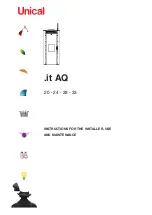
13
Connection to an external duct with
insulated or double wall pipe
Flue connection
Connection to an external duct with
insulated pipe or double wall
In this case only insulated stainless steel pipes
(double wall) smooth on the inside must be used
(flexible stainless steel pipes are forbidden)
fastened to the wall.
The base of the external vertical duct must
be fitted with an inspection port (“T” fitting) for
periodic check ups and cleaning, which must be
done yearly.
Perform airtight connection to the chimney
with fittings and pipes recommended by the
manufacturer. Ensure a wind-proof cowl is
installed according to regulations in force.
Check with adequate instruments that there is
proper draft.
Connection to chimney or flue duct
For proper operation, the connection between the
stove and the chimney or flue duct must not be at
less than a 3% angle, the length of the horizontal
branch must not exceed 2m and the vertical
branch between T fittings (change of direction)
must not be less than 1.5m. Check with adequate
instruments that there is proper draft.
The base of the external vertical duct must be
fitted with an inspection port for periodic check
ups and cleaning, which must be done yearly.
Perform airtight connection to the chimney
with fittings and pipes recommended by the
manufacturer.
Flue gas exhaust chimney
Avoid contact of the chimney with combustible
materials (e.g. wooden beams) and in any case
insulate them with fireproof material. In the event
of pipes running through wooden roofs or walls it
is recommended to use suitable certified through
kits, available on the market.
In the event of flue fire, turn off the stove,
disconnect it from the mains and never open the
door, then call the competent authorities.
Chimney
The chimney must meet the following
requirements:
• Have a cross-section and inner shape like that
of the flue.
• Have a useful outlet cross-section no less than
double that of the flue.
Flue gas exhaust connection
Insulate
external
ducting
Windproof
cowl
Inspection
Inspection
Flue














































